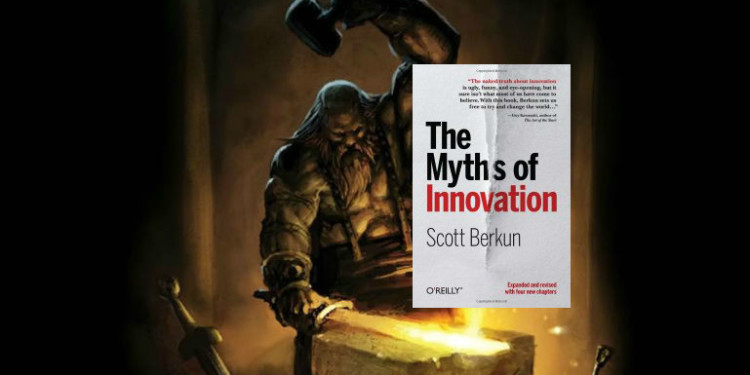The Myths of Innovation

Lone individuals are not the primary drivers of innovation. Hard work, incubation, non-linear progress, and rich environments are the best circumstances for innovation to thrive.
The Myths of Innovation by Scott Berkun
The Myths of Innovation provides a great perspective on what goes on behind the scenes of innovative ideas. He pokes holes primarily in the notion of epiphany, the spontaneous, external, insight that hits you from nowhere. From there, Berkun questions whether innovation and new ideas are always welcome. He also lists several myths that are related to process of innovation and how it is practiced. The book challenges the notion that new ideas look great when the arrive fully formed and everyone cheers their delivery. This masks the truth that new ideas don’t present themselves as full products, are typically met with heavy resistance, and are the result of twisting paths of hard work by multiple contributors.
Berkun’s essential message is that hard work, incubation, non-linear progress, and a rich environment are the best circumstances for innovation to thrive. He defines innovation through the customer’s eyes and suggests that for something to be innovative, a customer must say “this represents positive change for me.” Can you say “we innovate every day”? If innovations are true discontinuities, then can they be regularly scheduled?
Big ideas are a small part of innovation
He argues that the idea of the random epiphany is a myth because ideas never stand alone. The analogy he uses is putting together a puzzle. Is there anything special about the last piece that completes the puzzle? We forget all the other pieces which had to be in place before the location of the last one was evident. The perspective that’s required for a new approach often takes a long time and a lot of curiosity to formulate.
People who keep themselves busy all the time are generally not creative — Freeman Dyson
Berkun explores the concept of epiphany and unravels it a bit to conclude that it’s important to be idle. Being still and taking time to see a problem clearly are important in the incubation process. Idle time leads to better incubation and allows connections to be made between ideas (puzzle pieces). The long chains of experimentation and invention that lead up to great innovation are aided by the ability to make non-linear and illogical connections. Most books on innovation note that the most powerful new ideas come from the intersection of unrelated disciplines. This intertwined network of ideas and individuals also puts into question the belief in the lone inventor who hears the siren song of a muse. He notes that acknowledgement of individual contribution to innovation is a recent invention itself.
Until the innovation is accepted, it will be questioned relentlessly.
Two interesting myths he identifies are the idea that people love new ideas and that the best ideas win. Berkun quotes Howard H. Aiken as saying, “Don’t worry about people stealing your ideas. If your ideas are any good, you’ll have to ram them down people’s throats.” This is a key myth of innovation–the belief that people are welcoming and ready for new ideas and change to enter their lives. The ability to execute in a highly competitive environment and timing are critical to broad market adoption that the best idea frequently doesn’t win. The best idea is the one that gets adopted. Berkun notes that ideas are rejected on the basis of emotional reaction, not pragmatic evaluation.
How else will new knowledge appear to us, if not as strange, bizarre, or incomprehensible experiences?
In the second half of the book, Berkun gives some advice for generating ideas, getting them out of your head and into the world, and how to recover from rejection and failure. He advises focusing on being good rather than innovative because “most products out in the world are not very good.” He articulates this thought in a great post at BusinessWeek called “‘Good’ beats ‘Innovative’ every time” which is about the obsession with innovation, in contrast with “just trying to be good.”
Innovation is often just as much about clear definition of the problem as it is about inspiration, which supports Berkun’s point that it’s usually “hard work in one direction” (often by many people) that actually results in an innovation coming to life. An innovator’s natural curiosity will motivate the relentlessness required to follow all the paths which lead to the realization of new ideas.
In this talk at Carnegie Mellon, Berkun identifies the myths of innovation and describes the reality of invention. He makes the observation that creative (innovative) people have specific habits related to idea generation and follow-up, including a low inhibition for considering what might otherwise be irrelevant ideas. That’s why he suggests asking what happened before the moment of epiphany to really understand the origin of an innovation. The habits and behaviors that lead to the moments of inspiration are more important than the moments themselves.






